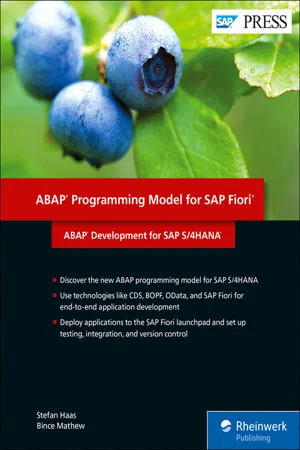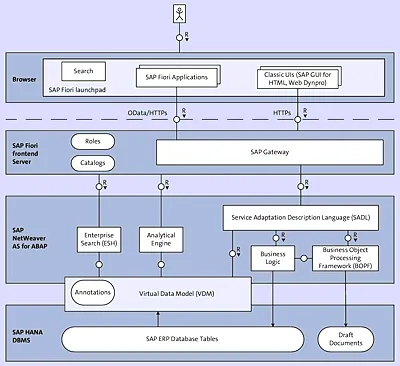
ABAP Programming Model for SAP Fiori
ABAP Development for SAP S/4HANA
- 461 pages
- English
- ePUB (mobile friendly)
- Available on iOS & Android
About this book
Combine your skills in ABAP, SAP Fiori, core data services, and more to master the end-to-end development process for SAP S/4HANA applications. Learn to use the ABAP programming model for SAP Fiori to build applications from scratch, or use SAP Fiori elements to get a head start! Then, deploy your applications to SAP Fiori launchpad and get the best practices you need to operate applications post-development, including Git version control, application tests, and setting up an integration pipeline.
a. Getting Started
Get the development foundation you need and master SAP S/4HANA architecture, SAP Fiori, design-led development strategies, and the ABAP programming model for SAP Fiori.
b. End-to-End Development
Use step-by-step instructions to develop in SAP S/4HANA using core data services, SAP Gateway, OData, service adaptation description language, and BOPF. Create list reports and object pages, overview pages, analytical list pages, freestyle applications, and more.
c. Operating Applications
Once your applications are developed and exported, get the best practices you need to operate them: Git version control, automated backend and frontend testing, and continuous integration for SAPUI5 and ABAP. 1) ABAP programming model for SAP Fiori
2) SAP Fiori
3) Git
4) SAP Web IDE
5) ABAP Test Cockpit
6) Core data services (CDS)
7) Business Object Processing Framework (BOPF)
8) Service Adaptation Description Language (SADL)
9) OData services
10) SAP S/4HANA Cloud SDK
Frequently asked questions
- Essential is ideal for learners and professionals who enjoy exploring a wide range of subjects. Access the Essential Library with 800,000+ trusted titles and best-sellers across business, personal growth, and the humanities. Includes unlimited reading time and Standard Read Aloud voice.
- Complete: Perfect for advanced learners and researchers needing full, unrestricted access. Unlock 1.4M+ books across hundreds of subjects, including academic and specialized titles. The Complete Plan also includes advanced features like Premium Read Aloud and Research Assistant.
Please note we cannot support devices running on iOS 13 and Android 7 or earlier. Learn more about using the app.
Information
Part I
1 SAP S/4HANA Architecture
1.1 Core Architecture
1.1.1 Overview

1.1.2 OData
1.1.3 SAP HANA
Table of contents
- Dear Reader
- Notes on Usage
- Table of Contents
- Preface
- Part I SAP S/4HANA and SAP Fiori
- 1 SAP S/4HANA Architecture
- 2 SAP Fiori and the Design-Led Development Process
- 3 ABAP Programing Model for SAP Fiori
- Part II Developing Applications for SAP S/4HANA
- 4 Developing an SAP Fiori Elements List Report and Object Page
- 5 Developing an Overview Page
- 6 Developing an Analytical List Page
- 7 Developing a Freestyle Application
- 8 Deploying Applications to the SAP Fiori Launchpad
- Part III Operating Applications
- 9 Version Control in SAP Web IDE Using Git
- 10 Automated Testing
- 11 Continuous Integration
- A Developing Applications on the SAP Cloud Platform
- B The Authors
- Index
- Service Pages
- Legal Notes